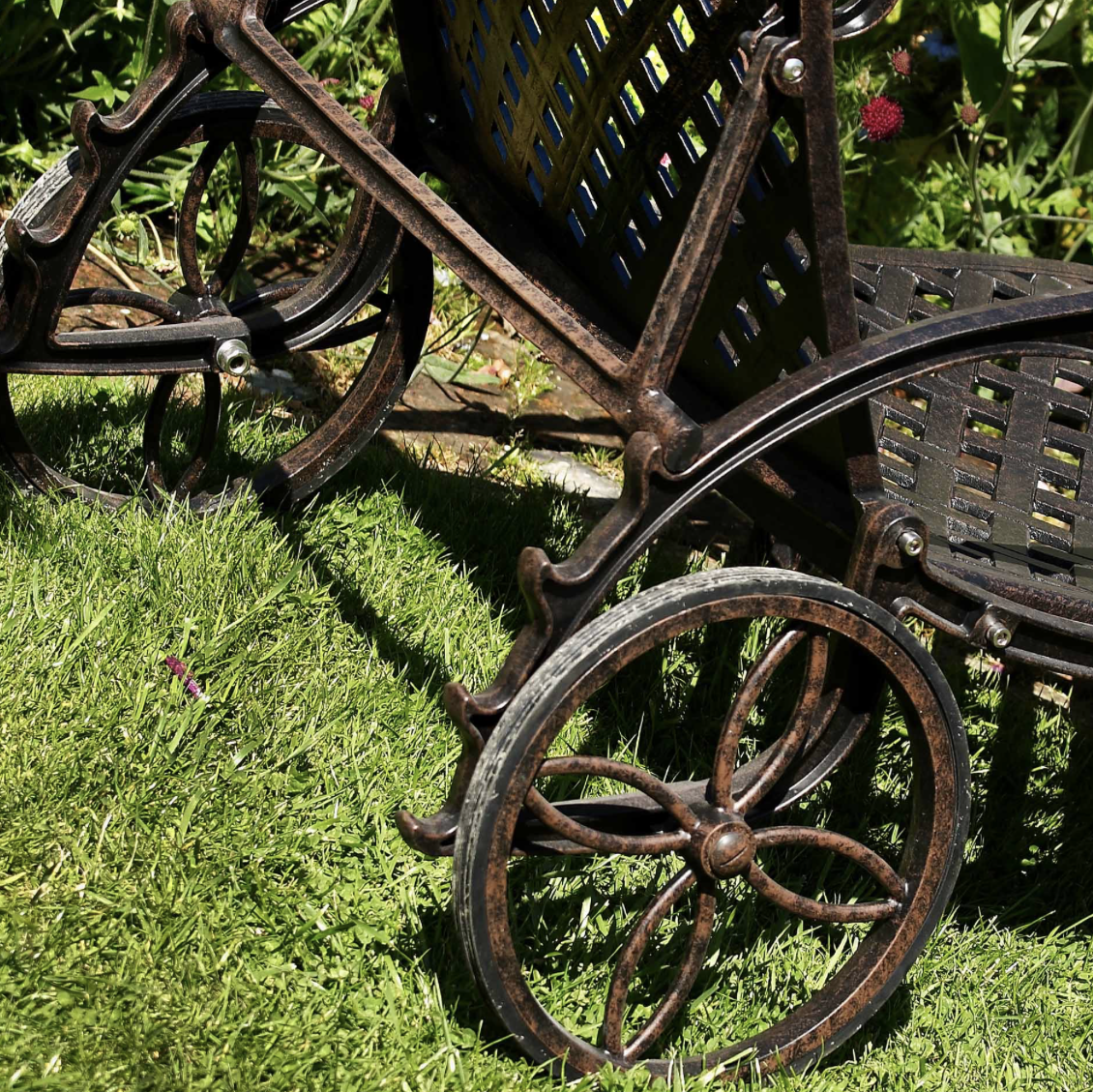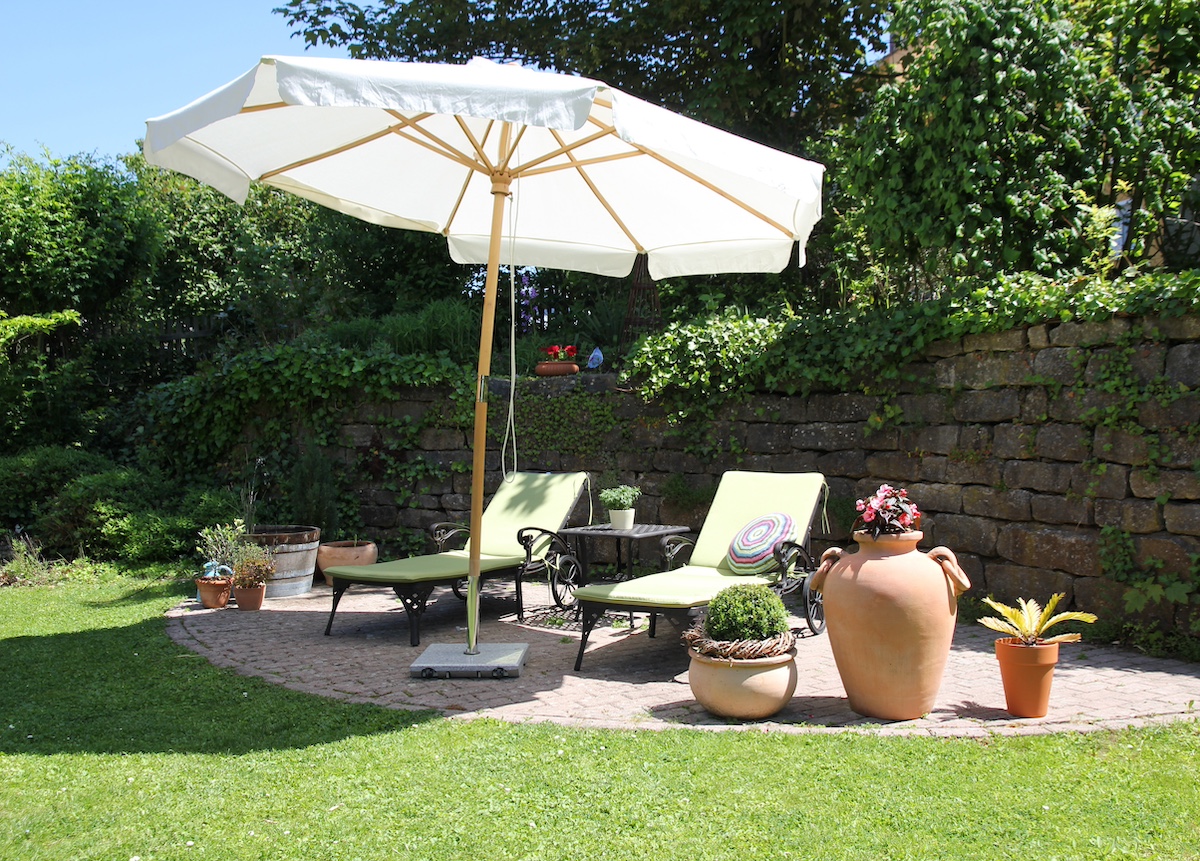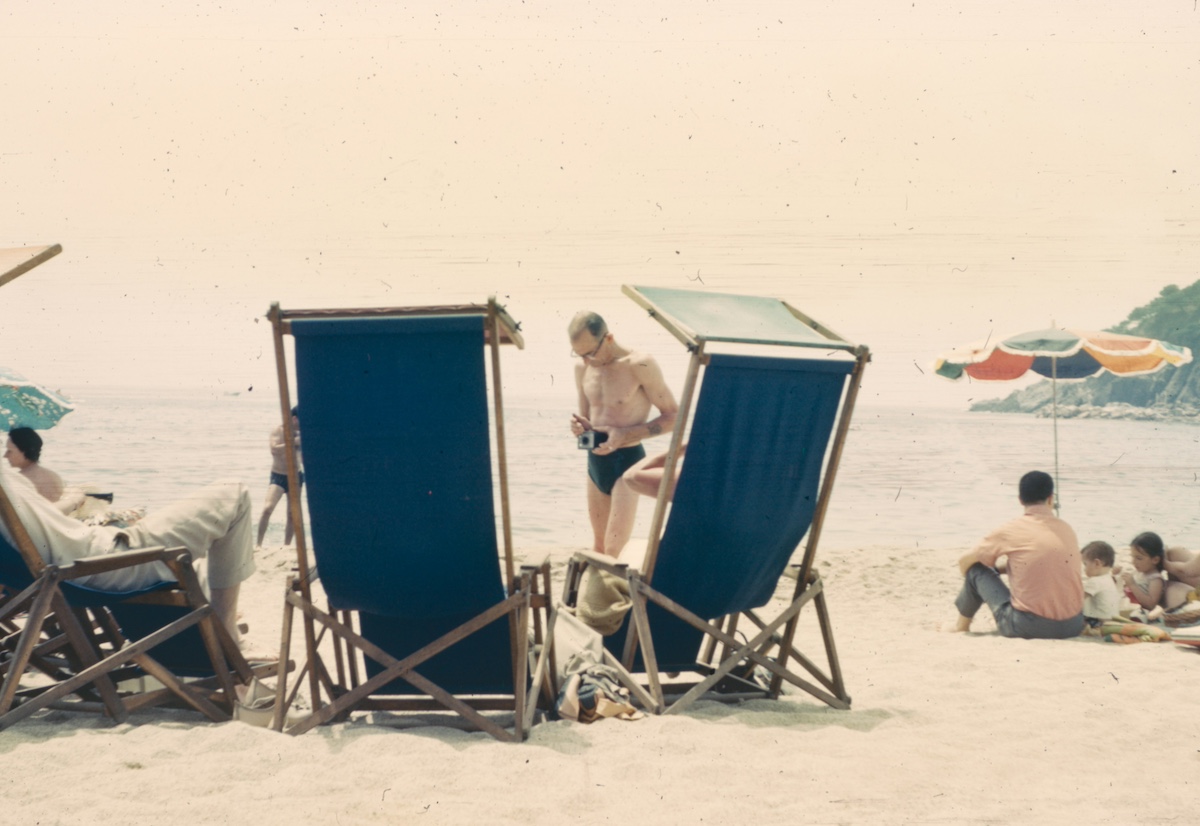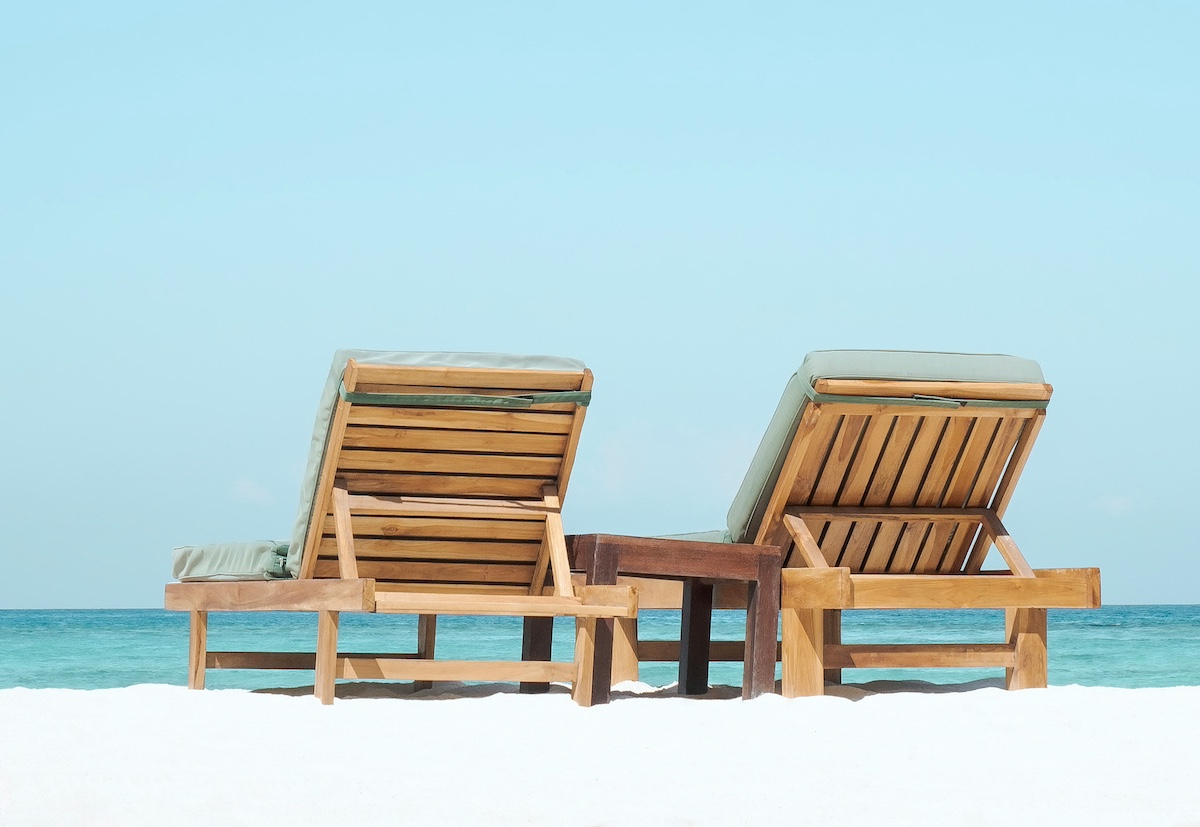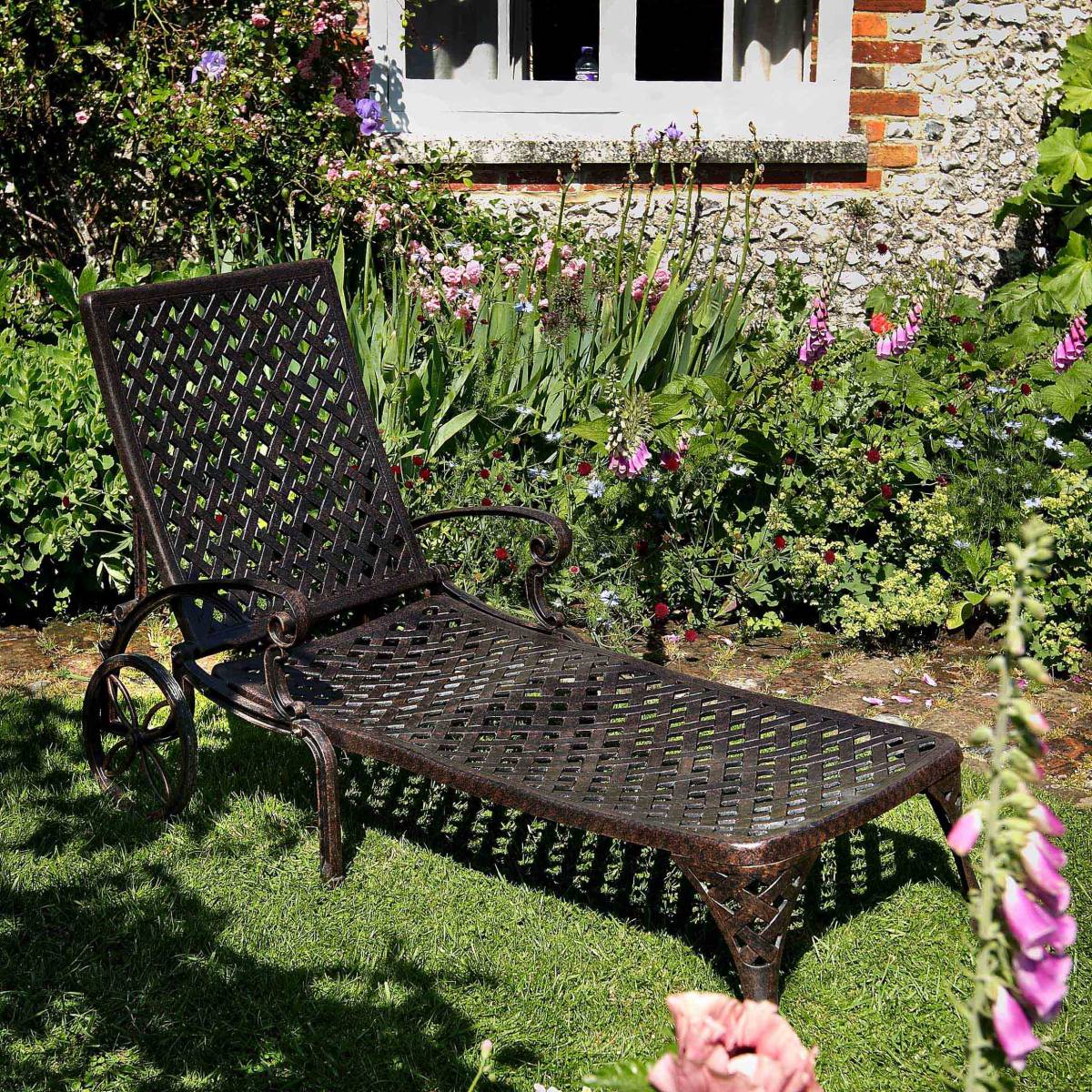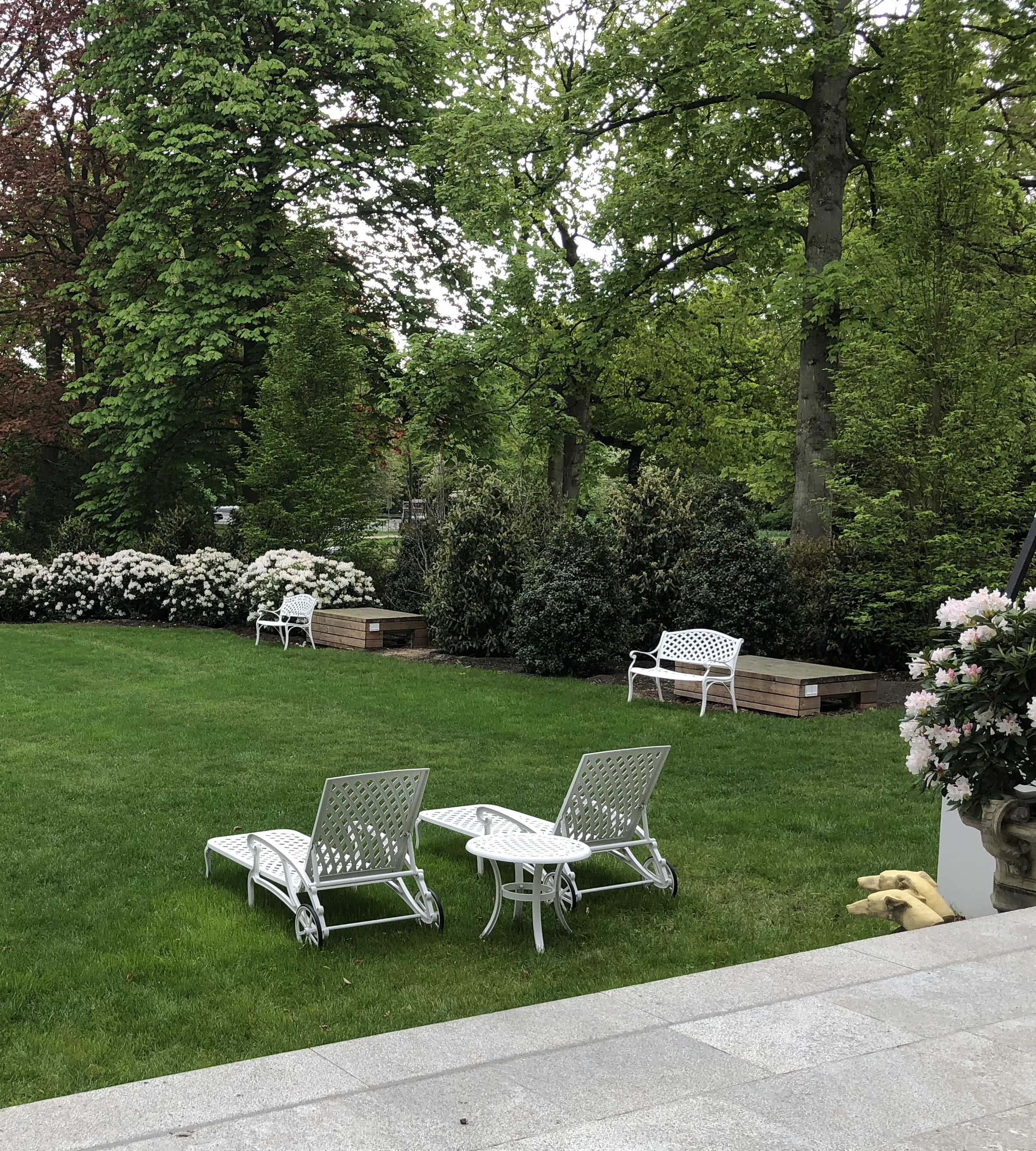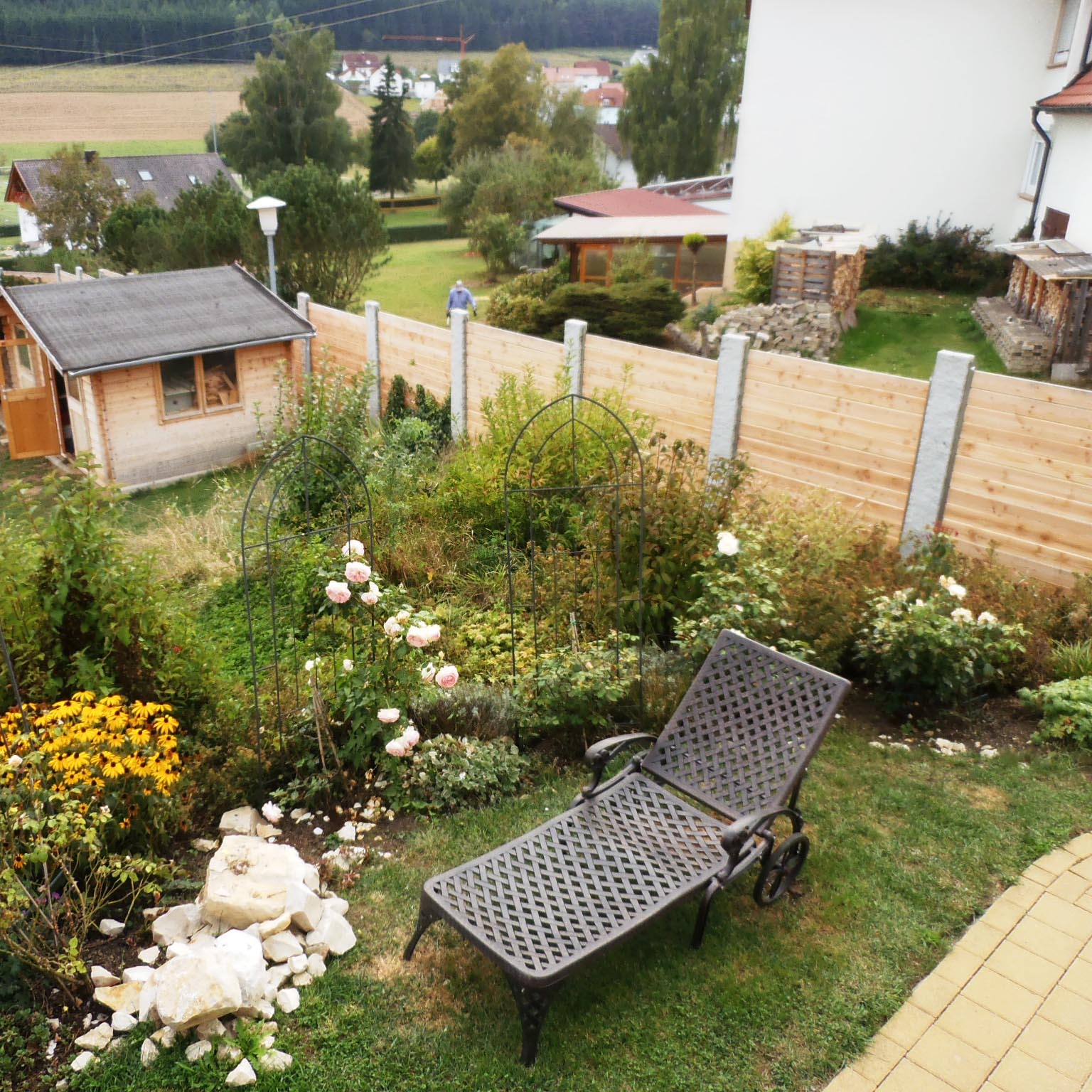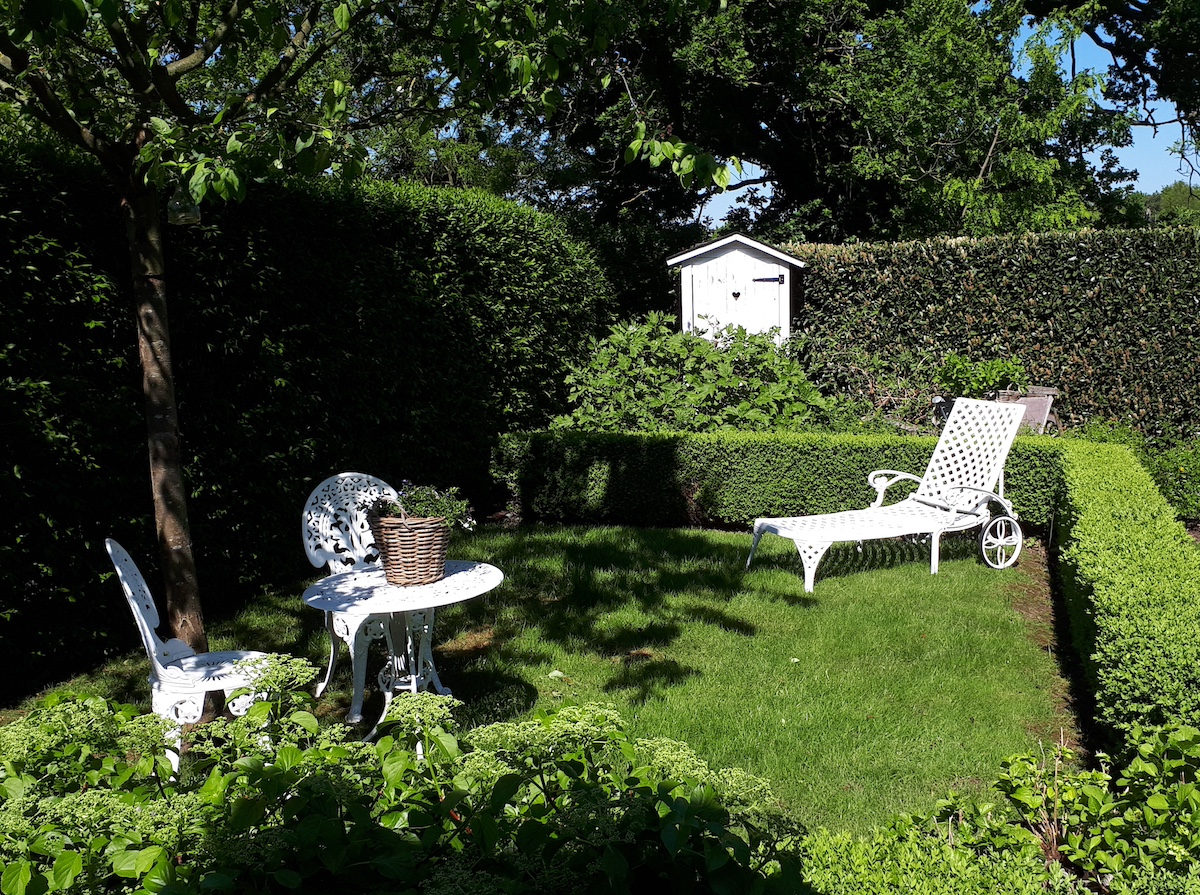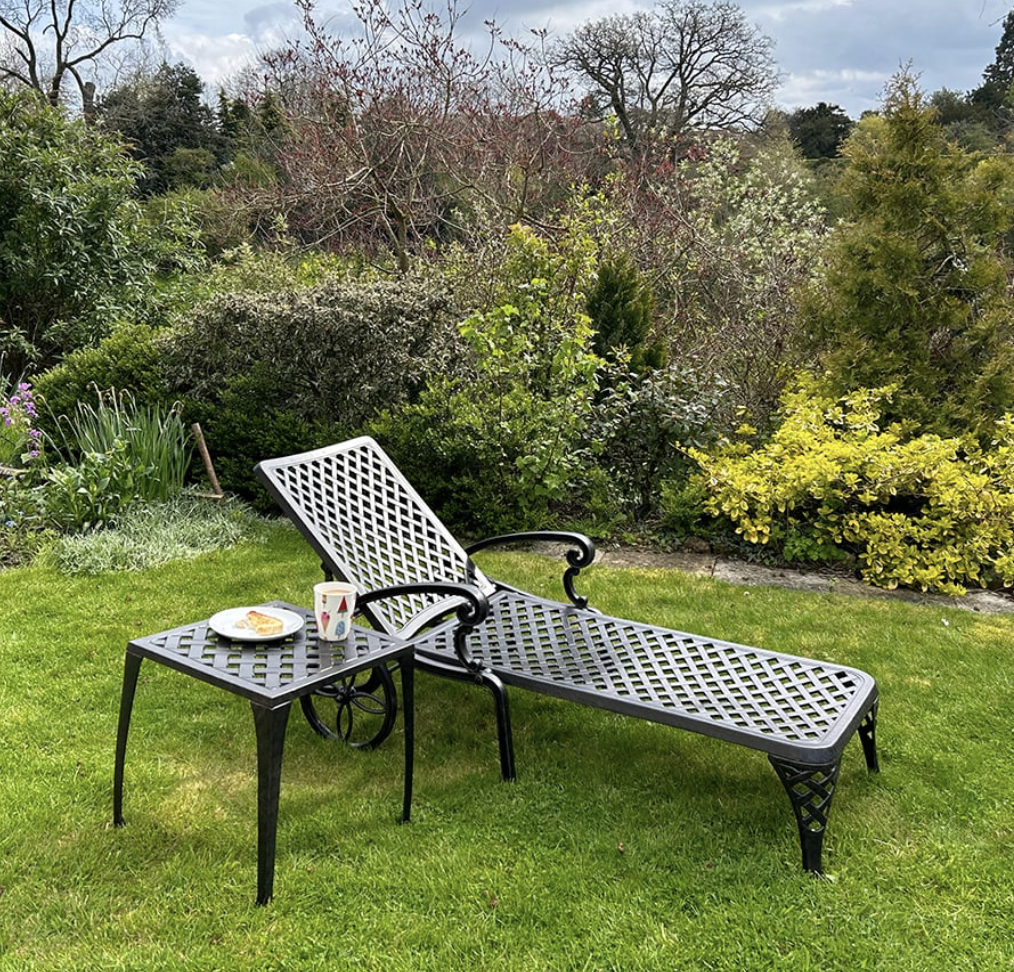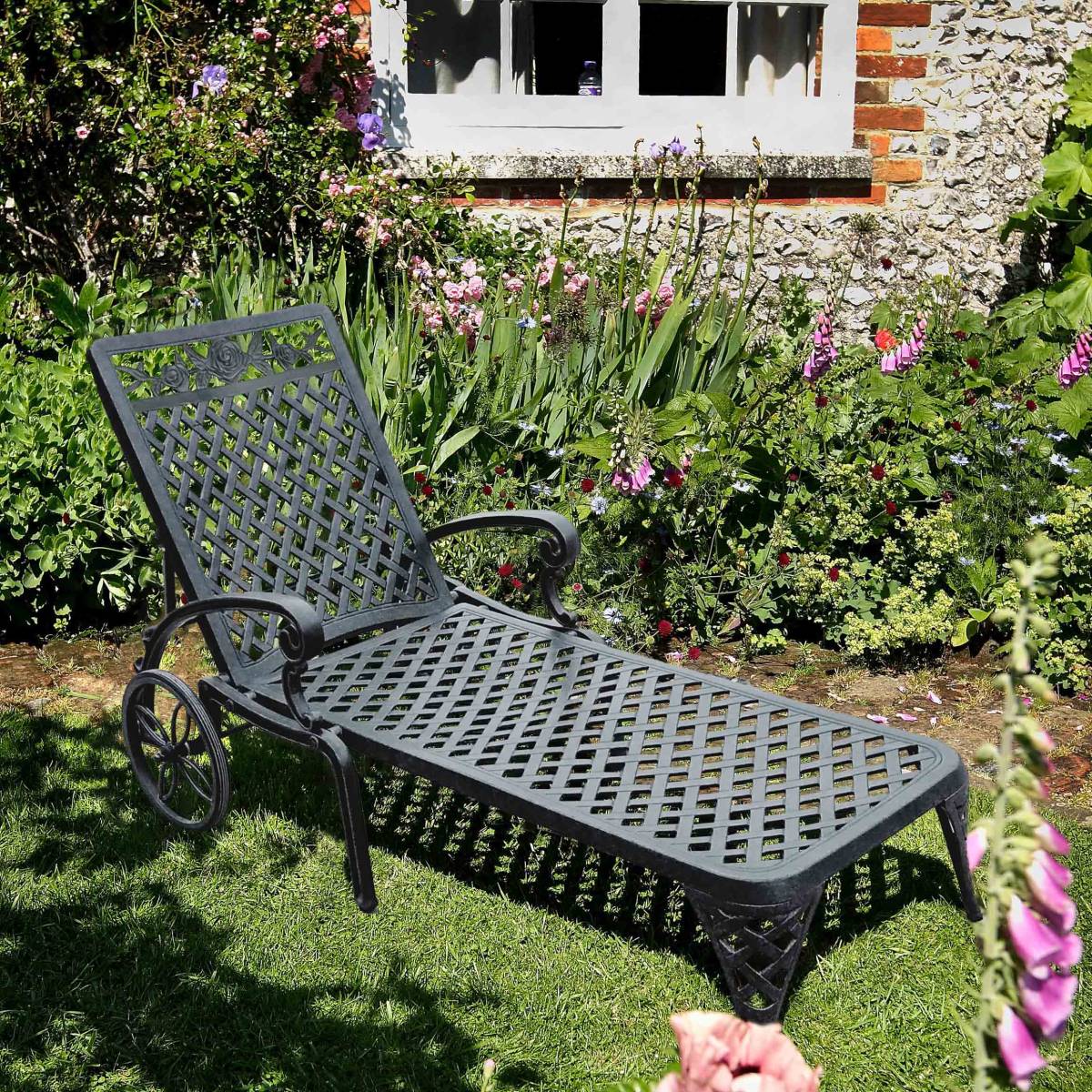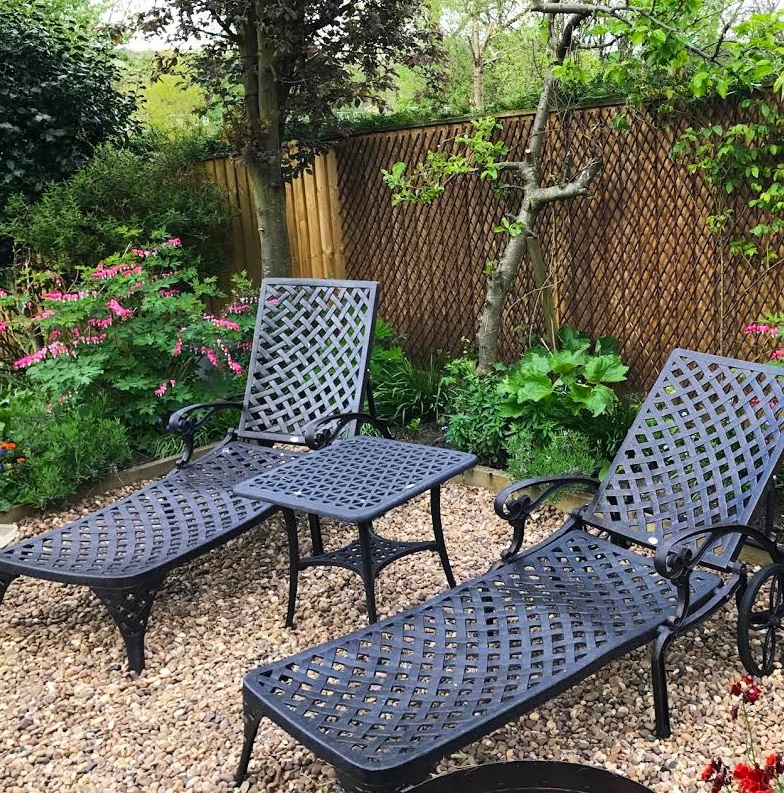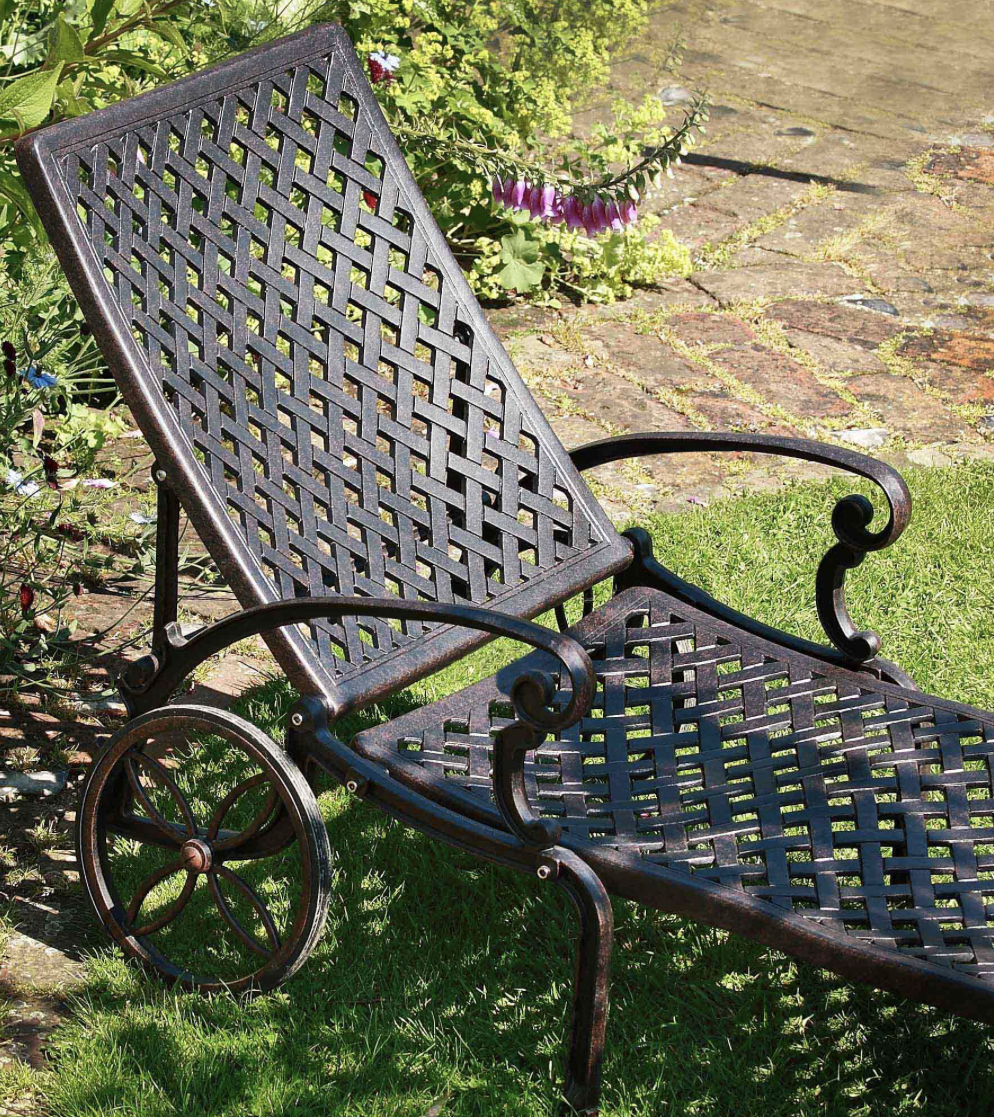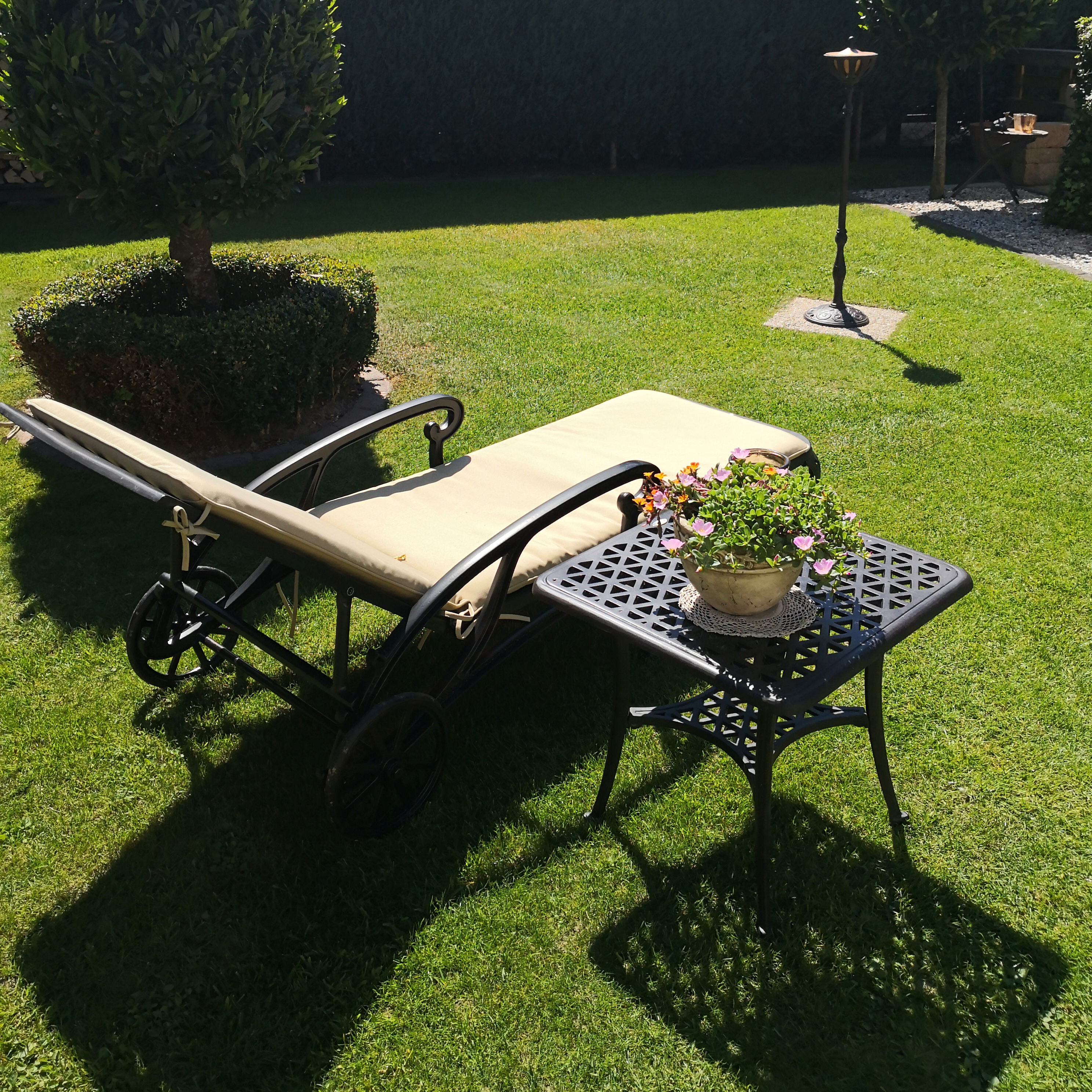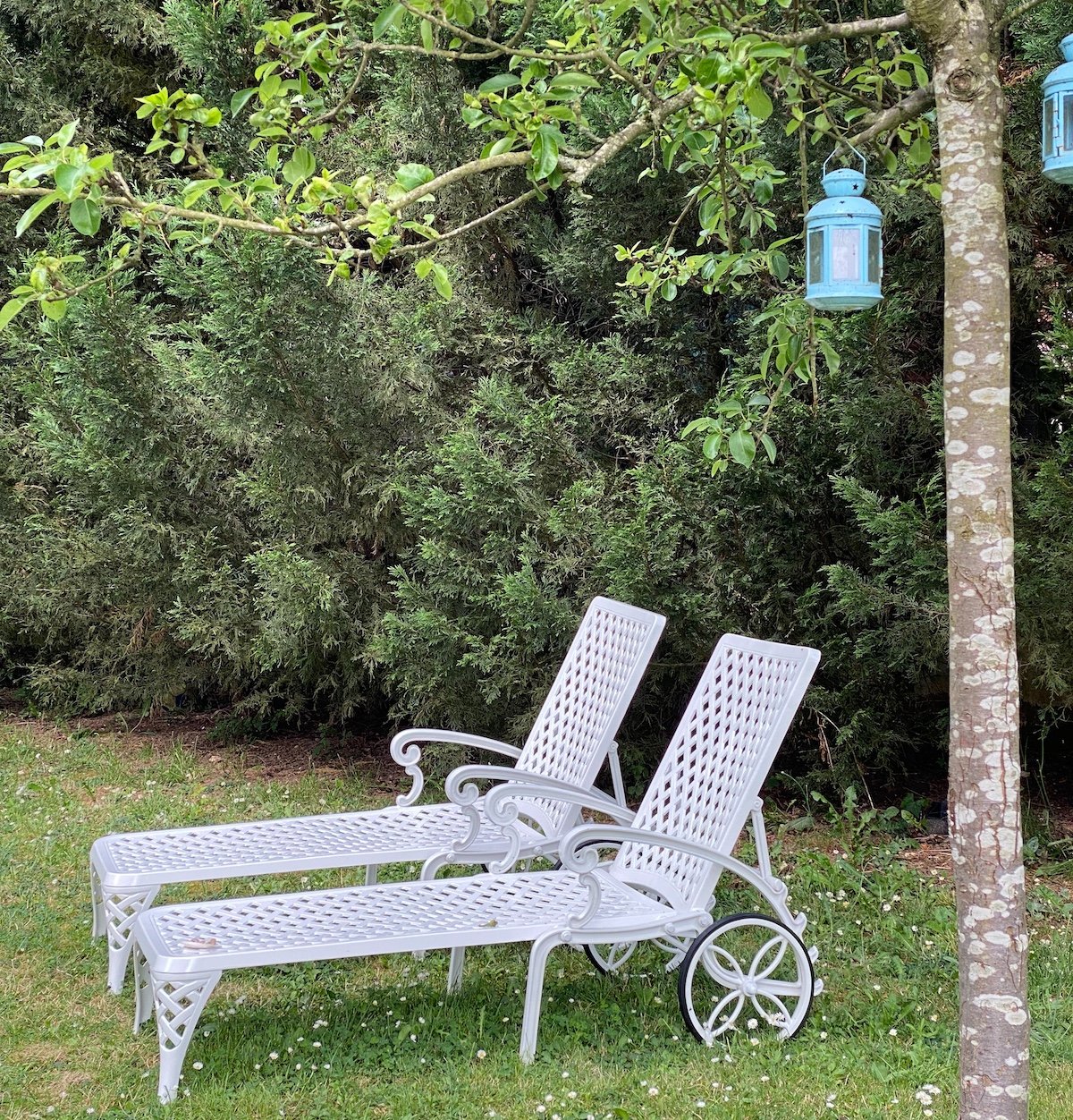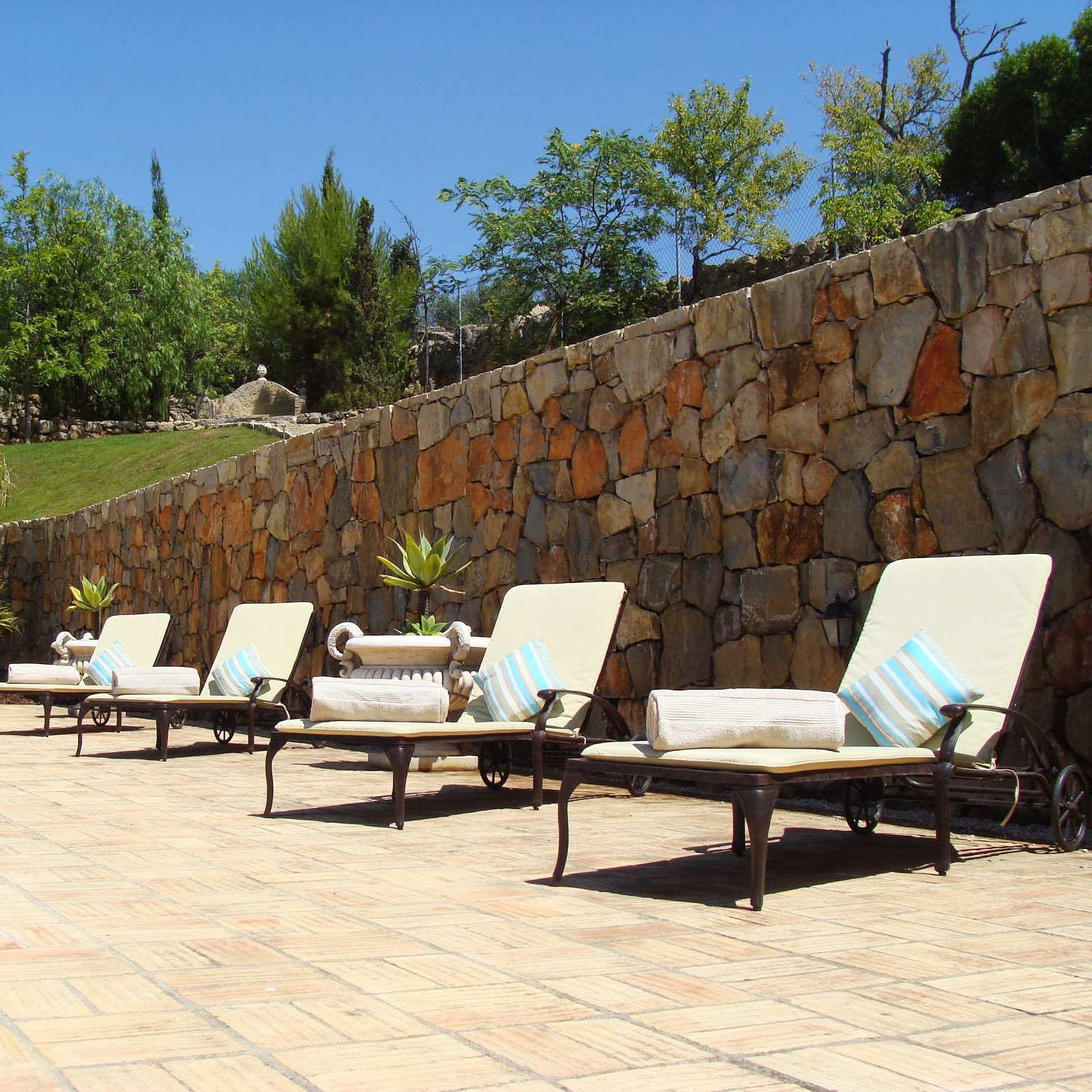We would define a garden sun lounger as a chair-like device that is designed for 100%-total-laid-back-feet-up relaxation. They’re the ideal piece to place next to a swimming pool, on a chilled garden patio, deck, balcony or even at the beach.
Across our industry, you’ll find them made from a wide variety of materials, including wood, plastic, or metals like our high-grade cast aluminium, or as a framework in all of those materials paired with a fabric or synthetic mesh sling.
The classic design that we’ve created features a solid metal construction with scrolled armrests, wheels for ease of movement, and an adjustable backrest that you can recline to different positions (pictured below on the close-up of our Stella lounger).
The Wikipedia definition of a sun lounger, or “sunlounger” if you’re from the US, is as follows:
“A sun lounger is a chair-like device, typically placed in a patio, garden, or swimming pool deck, or used as beach-side outdoor furniture. They are often constructed from wood, plastic, or metal and indoor fabrics. They have designed adjustable backs for people to lie down, or sit up on, (recline) while relaxing. Somewhat like a deckchair and bed-like in nature, the rear surface can be up to allow the user to sit up and read, or it can be reclined to a flat surface to allow sleeping in the horizontal position (supine and prone position).”
They’re the perfect solution for those who like to spend a lazy day in their gardens, whether that’s reading a book, taking a nap, sipping a cocktail, or simply kicking back and enjoying the sunshine on a summer’s day.
Loungers bring a touch of 5-star luxury to your outdoor space, and the adjustable backrest means you can sit upright, relax, or even lie flat to soak up the sun. For additional comfort, we also offer a range of Lattice Lounger Cushions (shown above in Green).
Adding a sun lounger or multiple loungers to your garden is a wonderful way to create a peaceful retreat where you can relax, recharge, and reconnect with nature.
Whether you're enjoying a leisurely afternoon basking in the sunshine, or stargazing under a night sky, a lounger will bring comfort and charm to your outdoor living experience.
This is our comprehensive guide to garden sun loungers, and in it, we will cover all aspects of selecting, using, and maintaining these stylish and practical pieces of outdoor furniture.
If you’re looking to purchase new, then hopefully this article will help you to make an informed purchase decision, introduce you to the Lazy Susan sun lounger collection for Summer 2024, and help you get the most out of your outdoor lounging experience.
A brief history of the sun lounger
The sun lounger, also commonly known as a sunbed or chaise longue (French for "long chair"), has a distinguished history dating back centuries, and the origins can be traced back to ancient civilisations in Egypt, Greece, and Rome, where people reclined on various types of outdoor 'bed' for relaxation and leisure purposes.
In ancient Egypt, for example, nobles would often recline on a raised stone platform or wooden bed to enjoy the sun's warmth. These platforms were typically adorned with cushions or grass matting for comfort.
Similarly, in ancient Greece and Rome, those of a higher status would recline on a chaise-longe-like piece of furniture known as a “lectus” or “kline”, which was a half bed half chair with an upright backrest that was popular for dining, socialising, and relaxation.
These pieces were often elaborately decorated or carved and were seen as symbols of wealth and power. The concept of the modern sun lounger as we know it today, began to emerge in the late 19th and early 20th centuries.
During this time in the UK, there was a significant rise in seaside resorts, and sunbathing quickly became a popular leisure activity.
An influx of visitors arriving via newly constructed railways motivated entrepreneurs to build new resorts, attractions, hotels, guest houses, etc, leading to more visitors and rapid growth throughout the 1850s and 60s.
With this was a need to create outdoor furniture specifically for soaking up the sun, so furniture designers began developing several solutions. One notable precursor to the modern sun lounger is the foldable deck chair, which gained popularity in the late 19th century.
Throughout the 20th century, furniture designers continued to innovate and refine the sun lounger, experimenting with materials and features for optimal comfort and functionality.
Today, the modern lounger comes in a variety of designs, styles and materials, but the basic half-seat/half-bed concept has endured. It remains a staple of our industry, whether they’re used by the pool, on the beach, in a hotel spa, or our own back gardens.
What are the different lounger materials available?
In the UK, you’ll find sun loungers made from various materials to suit different tastes and outdoor settings.
Some of the common materials include:
-
Wooden Loungers
A Wooden sun lounger is often made from teak, cedar, or other hardwoods, wooden loungers are known for their style and durability. They often feature a slatted design and include cushions for added comfort. -
Wicker Loungers
Wicker loungers are popular for their elegant modern look and are also often supplied with cushions or pillows for extra comfort. Most on sale in the UK are now made from a synthetic resin poly-rattan that is lightweight, durable and water-resistant. -
Metal Loungers
Metal sun loungers in the UK are commonly made from cast aluminium or stainless steel and they are sturdy and weather-resistant. Powder-coated finishes provide extra protection against rust and corrosion. Cast aluminium like we sell here at Lazy Susan is timeless, lightweight, easy to maintain, and durable, making it ideal for the UK climate. We look at their suitability for warmer climes in our Can you use metal sun loungers in a hot climate? article. -
Resin Loungers
Resin loungers are made from synthetic materials like Polyethylene (PE) or Polyphenylene Ether (PPE). They are lightweight, easy to clean, water-resistant, and come in a variety of colours and styles. -
Fabric Loungers
Many sun loungers often feature a frame made from the materials above paired with a seat and backrest made from a breathable mesh fabric. This material is weather-resistant, quick-drying, and easy to clean, making it a practical and comfortable option for outdoor lounging.
We've recently taken a closer look at what we think are the 5 best sun lounger materials in terms of which are the most durable and lowest maintenance in our What is the best sun lounger material for easy care and maintenance? article.
What are the different types of sun loungers?
There are several different designs or types of sun loungers available to buy in-store and online in the UK, each offering unique features to suit different needs and wants.
Here are some of the common types:
-
Folding Lounger
Folding sun loungers are designed for ease of storage and transportation. They typically feature a collapsable frame made from a lightweight metal such as aluminium and are often paired with a fabric or mesh seat. -
Double Lounger
Double loungers are designed to accommodate two people comfortably. They have a wider seating area and often come with shared or separate adjustable backrests. -
Inflatable Lounger
Inflatable loungers are portable and easy to set up. They can be inflated with air and are often made of durable materials like nylon or PVC. Inflatable loungers are great for camping, beach trips, or lounging by the pool. -
Floating Lounger
Floating loungers are designed to be used in the water, such as in swimming pools or the sea. They are typically made of buoyant materials and often feature built-in cup holders or resin mesh seating. -
Adjustable Lounger
Adjustable loungers like the style we sell here at Lazy Susan (pictured above) allow users to customise their seating position for maximum comfort. They often have multiple reclining positions and may include features like armrests and wheels for comfort and easy relocation. -
Chaise Longue
A garden chaise longue is very similar to the above in that it typically features a long, reclining seat with a backrest that provides a comfortable place to sit or lie down. The key difference is they often have an elongated armrest that doubles as another backrest meaning it is more half sofa-style seat/lounger. -
Day Bed
A day bed is a larger outdoor furniture piece designed for relaxation and comfort in a garden or patio setting. They typically resemble a large, luxurious sofa or bed and are often accompanied by soft cushions and pillows for added comfort. Also popular with many modern designs is a canopy or some form of overhead shading to protect from the sun.
These are just a few examples of the popular types of loungers available to buy in the UK. Each type offers its own set of features and benefits, allowing you to pick and choose the perfect lounging experience for your outdoor space.
Why buy a sun lounger for your outdoor space?
Investing in a sun lounger for your garden, even in the UK where our summers are a little temperamental, will offer several benefits and help to greatly enhance your outdoor experience in many different ways:
-
Comfort
A sun lounger provides a comfortable and supportive place to relax and unwind in your garden. Whether you want to soak up the sun, read a good book, or take a nap, a sun lounger offers a cosy spot to do so. -
Outdoor Living
Adding a sun lounger to your garden extends your living space too. It provides an inviting area to spend time with family and friends, whether lounging by yourself or hosting a summer gathering with friends and family. -
Health
Spending time outdoors has been shown to have numerous health benefits, including reducing stress, improving mood, and boosting vitamin D. A sun lounger allows you to enjoy these benefits while basking in your garden. -
Style
A stylish sun lounger can enhance the look and feel of your garden and serve as a focal point or statement piece. Choose a lounger that complements your existing outdoor decor and adds a touch of elegance to your garden space. -
Relaxation
With adjustable features like reclining backrests, many sun loungers offer customisable comfort to suit your relaxation needs. You can find the perfect lounging position for reading, sunbathing, or simply enjoying the tranquillity of your garden.
Overall, investing in a sun lounger for your garden is a fab way to enrich your outdoor living experience, promote relaxation and well-being, and create a tranquil spot in your garden.
How do you choose a new sun lounger for your garden?
Choosing the right type of sun lounger involves considering various factors to ensure it meets your needs and wants. This is our simple step-by-step guide to help you choose a new sun lounger for your garden:
-
Space
Measure carefully and evaluate the size and layout of your garden or outdoor space. Measure the area where you plan to put it/them and check the dimensions of the lounger to ensure it fits comfortably without overcrowding the space. -
Requirements
Think about how you intend to use the sun lounger. Are you looking for a spot to sunbathe or relax with a book? Consider your specific needs and preferences, such as adjustable features, cushioning, and additional amenities like side tables or a parasol and base. -
Material
Sun loungers come in a variety of materials, each offering different benefits and styles. Consider factors such as durability, weather resistance, maintenance requirements, and how well the material will complement your home and garden. -
Comfort
If buying online it can be difficult to gauge comfort so look for features like adjustable reclining positions, ergonomic design, and cushioned padding for enhanced comfort. -
Quality
Invest in a sun lounger made from high-quality materials that are designed for outside use, built to last, and require little in the way of maintenance. They might cost you more upfront but they will last longer and you won’t need to spend time and money on re-applying weatherproof coatings. -
Storage
If you plan to move or store the sun loungers frequently, then consider portability and storage options. Look for lightweight designs, wheels, folding mechanisms, or stackable features that make it easy to transport and store when you’re not using them. -
Style
Select a design and material that best complements your garden decor and personal style. Whether you prefer a timeless look or a sleek minimal design, choose a lounger that fits with the “look” of your outdoor space. -
Reviews
Research different sun loungers online and read reviews from other customers to gain valuable insight into their quality, performance, and durability. Compare features, prices, and guarantees to make an informed choice. -
Budget
Set a budget for a sun lounger and explore options within your price range. As we touched on under quality, be sure to consider the long-term value and investment of a high-quality sun lounger that is built to last with minimal fuss.
By considering the factors above and taking a little time to research the market, and weigh up the different options, you can choose a sun lounger that meets your needs, complements your outside space, and provides all-day lounging comfort.
The Lazy Susan garden sun lounger collection for Summer 24
With our sun lounger collection, we want you to make the most of your garden with our maintenance-free sun loungers. You can sit back, relax and enjoy the sunshine.
Our loungers feature a solid design in rust-resistant cast aluminium, which is powder-coated to further protect it from the elements.
The timeless design features our signature latticework so they coordinate perfectly with our garden tables, chairs, benches and accessories.
With a choice of backrest positions, they can be easily adjusted to allow you to sit more upright or recline in complete comfort.
Weatherproof and easy to maintain, our metal sun loungers are easy to move around thanks to their lightweight aluminium design and stylish wheeled design.
You can also pair our sun loungers with our water-resistant, fast-drying cushions and a matching parasol and base for the ultimate in summer comfort:
Stella Lounger in Antique Bronze, Slate Grey & White
Our Stella is a 177 cm long classic reclining metal sun lounger that features our trademark latticework paired with a scrolled design on the armrests, rear wheels and fluted front legs.
Stella will bring an instant touch of elegance to any garden space and, weighing in at only 26kg, makes moving them around until you find the perfect sunny spot a simple task.
Available in our Antique Bronze (shown above), Slate Grey and White finishes.
Rose Lounger in Antique Bronze, Slate Grey & White
Our 177 cm long reclining metal Rose lounger also features our classic metalwork, this time pairing our signature lattice work with the beautiful rose motif found on many of our garden chairs and tables on the backrest.
Relaxing in the sun has never been more comfortable or stylish, and with it also weighing in at only 26kg, it is easy to move around your patio.
Available in our Antique Bronze, Slate Grey (pictured above) and White finishes.
How to clean and maintain our cast aluminium sun loungers
Cleaning and maintaining a cast aluminium garden lounger is relatively straightforward. There is no need to re-paint or stain them as the durable powder-coated finish will keep them protected from the elements.
However, a little regular TLC will help to keep them clean, and ready to use, and further prolong their lifespan to keep your loungers looking great for many years.
This is our simple step-by-step process:
-
Clean
Start by regularly cleaning your sun loungers to prevent dirt and grime from building up, especially if they are left outside. Washing up liquid or a car shampoo in warm water is all you need. Avoid using any harsh chemicals or abrasive cleaners as they could damage the finish. -
Wash
Use a soft-bristled brush, sponge or cloth to wash the surface of the lounger gently, being sure to get in between the latticework. -
Rinse
After washing, rinse the chair thoroughly with clean water to remove any soap residue or loose dirt. A garden hose on a spray setting will suffice. Pressure washers are too powerful but if you do use them, turn them down to low. -
Dry
Allow the chair to air dry completely. Make sure it's dry before putting any cushions on it or storing it. -
Wax
This is optional but we like to apply a light coat of a carnauba-style car wax to give the paintwork a nice finish. This also helps water bead and run off, keeping them cleaner and drying faster. -
Oil
Apply a little squirt of oil to the wheels and backrest to lubricate and reduce the likelihood of squeaks and creaks developing. -
Store
During the winter or extended periods of non-use, consider storing or covering your cast aluminium loungers to keep them clean and ready to use. -
Inspect
Periodically inspect your sun loungers for any scratches and chips and to check the screw-in feet are in place. Address any issues promptly to prevent them from worsening. -
Repair
If you do find a chip or scratch, then touch it up with our easy-to-apply kits. You will find them and packs of replacement feet in our spare parts shop.
By following these 9 steps, you can keep your cast aluminium lounger clean, well-maintained, and looking its best for many summers to come.
How to place and arrange loungers on your patio
Arranging a sun lounger effectively in your garden or on a deck or patio area depends on things like the layout of your outdoor space, and the desired level of comfort and convenience.
Here are some tips for effectively arranging a sun lounger in your outside space:
-
Position
The best place to put your lounger(s) will depend on your preferences and the layout of your garden. Experiment with different positions to find what works best for you in terms of comfort, style, and function. If you like to sunbathe, it is in an area that receives ample sunlight. -
Orientation
Position the sun lounger so that it faces the direction you find most appealing. You might want to face towards a scenic view, towards your house or garden, or a swimming pool if you’re lucky to have one. -
Comfort
Ensure that the loungers are placed on a flat and stable surface to prevent them from wobbling. Our screw-in feet will provide a little adjustment for uneven patio surfaces. Pair with our lattice cushions for extra comfort and adjust the reclining angle to your liking. -
Access
Place your sun lounger within easy reach of amenities you might need, such as the bathroom or kitchen. Alternatively, pair with a side table for drinks, snacks, sunscreen, a book, etc. -
Privacy
Position your loungers in a secluded part of the garden where you’re not overlooked or use privacy screens or tall planting to create a more intimate space. -
Safety
We look at safety in greater detail in a moment but if you're using the sun lounger near a pool, for example, then make sure you place it a safe distance from the edge to prevent accidents. -
Group
If you have multiple sun loungers, then you can arrange them in a group for socialising or relaxation with friends and family. Leave enough space between each lounger for easy movement around the space.
The best way to arrange a sun lounger or multiple loungers is to create a set-up that meets your individual needs and allows you to relax and enjoy your outdoor space. Experiment with a few different layouts until you find the spot that looks and functions best.
How to accessorise your garden loungers
Accessorising our sun loungers will greatly enhance both their functionality and aesthetic appeal, helping to create a more inviting and comfortable outdoor relaxation zone.
Here are some of our favourite ways to accessorise our metal loungers:
-
Cushions
Add our soft lattice lounger cushions for extra comfort and support. Made from a quick-drying water-resistant fabric they are available in a range of colours to complement your outdoor decor. -
Throw Blankets
For cooler evenings or added cosiness, drape a lightweight outdoor throw blanket over your sun lounger. Choose materials like cotton or acrylic that are easy to clean. -
Side Table
Place one of our small side tables such as Willow or Sandra (shown above) next to the sun lounger to hold drinks, snacks, sunscreen, books, or electronic devices like iPhones and iPads. They are made from the same lightweight but robust cast aluminium as our loungers and are available in the same colours so you will coordinate perfectly. -
Parasol & Base
Provide shade and protection from the sun by adding one of our parasols next to your sun lounger. This will allow you to enjoy your outdoor space comfortably, even during the hottest parts of the day. Plus, they are shower-resistant so they’ll keep things dry if there’s a sudden downpour. -
Book/iPad Holder
Consider adding a book or iPad holder for easy access and reading while lounging. Choose a waterproof or weather-resistant option to protect your reading materials. -
Outdoor Rug
Define the lounging area and add visual interest by placing an outdoor rug underneath or adjacent to your sun lounger. Choose a rug that complements your outdoor decor and is durable enough to withstand outdoor conditions. -
Planting
Add greenery and natural beauty to your outdoor space by placing potted plants or flowers near or around your sun lounger. Choose low-maintenance plants that thrive in that part of your garden. -
Speaker
Set the mood with your favourite music by adding a Bluetooth speaker to your outdoor lounging area. Look for a durable, portable, weather-resistant speaker that is designed for outdoor use.
Customising your sun lounger with personal touches such as decorative lanterns, candles, or outdoor artwork that reflect your personality and style is a great way to make the space a chill-out zone. By accessorising your lounger with decorative elements, you can create a comfortable, inviting, and stylish outdoor retreat where you will relax and unwind in style when the sun is shining.
How to safely use a garden sun lounger
Using a garden sun lounger safely will ensure that you can relax and enjoy your outdoor space without the risk of injury. Here are some tips for safely using our loungers:
-
Stability
Before using our loungers, ensure that the screw-in feet are fixed securely and adjust them to level on uneven surfaces. Avoid placing it on uneven ground or surfaces that could cause the lounger to tip. -
Weight
Avoid overloading your sun lounger beyond its capacity as this can compromise its stability and lead to accidents. -
Position
Adjust the reclining angle of the lounger to a comfortable position. -
Cushions
Pair with cushions for extra comfort and support. Ensure that they are securely tied in place and won't slip or slide off while you're using the lounger. -
Sun Exposure
It is essential to protect yourself from sunburn and heat exhaustion by applying sunscreen, wearing a hat, and staying hydrated while using the sun lounger in hot weather. Consider using a parasol for added protection from UV rays. -
Falls
Use caution when getting on and off the sun lounger to avoid slipping or falling. Hold onto the armrests for stability. -
Children
If children are using the sun lounger, supervise them closely to ensure their safety. Make sure they understand how to use the lounger safely and avoid rough play or climbing on it. -
Damage
Regularly inspect the sun lounger for any signs of damage, such as loose bolts, or chips. Address any issues promptly to prevent accidents or injury. -
Wind
Avoid using the sun lounger on windy days and move it to a secure/sheltered part of the garden or inside if there is a weather warning.
By following these safety tips, you can enjoy your garden sun lounger responsibly and minimise the risk of accident or injury when using it.
Is there a trade discount on Lazy Susan sun loungers?
We offer our trade clients an exclusive discount on all bulk purchases of our beautifully crafted outdoor furniture.
Our maintenance-free sun loungers can be found at many wonderful pools, hotels, spas and holiday lets, and we’re the proud garden furniture suppliers to more than 500 businesses across the UK & Europe.
To apply, or for more information, please register your details in the form via the link below, and we will be in touch with your discount code (valid on full-price items only).
Register now for your exclusive trade discount
If you have any photos of your new Lazy Susan Garden Sun Loungers, we’d love to see a few for our Do Some Good charity campaign. You can tag us @LazySusanFurniture on Instagram or Facebook or Upload Here.
Related Garden Sun Lounger Articles:
- What is the best sun lounger material for easy care and maintenance?
This month we’re asking what is the best sun lounger material and picking our 5 favourite low-maintenance options...
Read More - Can you use metal sun loungers in a hot climate?
In this article, we’re discussing whether you can use metal sun loungers if you live somewhere with a climate warmer than the UK...
Read More




